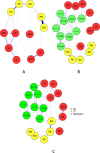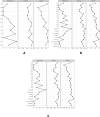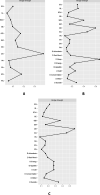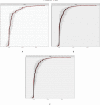The bridge symptoms of childhood trauma, sleep disorder and depressive symptoms: a network analysis
- PMID: 37403102
- PMCID: PMC10320961
- DOI: 10.1186/s13034-023-00635-6
The bridge symptoms of childhood trauma, sleep disorder and depressive symptoms: a network analysis
Abstract
Background: This study aimed to elucidate the characteristics of symptom network of childhood trauma (CT) and sleep disorder (SD) in Chinese adolescents, with the influence of depressive symptoms taken into account.
Method: A total of 1301 adolescent students were included, and their CT, SD and depressive symptoms were measured using the Pittsburgh sleep quality index (PSQI), the Childhood Trauma Questionnaire-Short Form (CTQ-SF), and The Patient Health Questionnaire-9 (PHQ-9), respectively. Central symptoms and bridge symptoms were identified based on centrality indices and bridge centrality indices, respectively. Network stability was examined using the case-dropping procedure.
Results: In CT and SD symptom network, emotional abuse and sleep quality symptoms had the highest centrality values, and two bridge symptoms, i.e., emotional abuse and sleep disturbance symptoms, were also identified. In symptom network for CT, SD, and depressive symptoms, sleeping difficulty symptoms, daily dysfunction symptoms, and emotional abuse appeared to be potential bridge symptoms. In symptom network of CT, SD, and depressive symptoms (excluding the symptom of sleeping difficulty), daily dysfunction symptoms, emotional abuse, and sleep disturbance symptoms appeared to be bridge symptoms.
Conclusions: In this study, emotional abuse and poor sleep quality were found to be central symptoms in the CT-SD network structure among Chinese adolescent students, with daytime dysfunction as the bridge symptom in the CT-SD-depression network structure. Systemic multi-level interventions targeting the central symptoms and bridge symptoms may be effective in alleviating the co-occurrence of CT, SD and depression in this population.
Keywords: Adolescent; Bridge symptoms; Childhood trauma; Sleep disorder; Symptom network.
© 2023. The Author(s).
Conflict of interest statement
The authors declare no competing interests.
Figures




Similar articles
-
The Bridge Symptoms of Work-Family Conflict, Sleep Disorder, and Job Burnout: A Network Analysis.Depress Anxiety. 2024 Nov 4;2024:2499188. doi: 10.1155/2024/2499188. eCollection 2024. Depress Anxiety. 2024. PMID: 40226734 Free PMC article.
-
Network analysis of anxiety and depressive symptoms among nursing students during the COVID-19 pandemic.J Affect Disord. 2021 Nov 1;294:753-760. doi: 10.1016/j.jad.2021.07.072. Epub 2021 Jul 22. J Affect Disord. 2021. PMID: 34375200 Free PMC article.
-
Network analysis of internet addiction and sleep disturbance symptoms.Prog Neuropsychopharmacol Biol Psychiatry. 2023 Jul 13;125:110737. doi: 10.1016/j.pnpbp.2023.110737. Epub 2023 Mar 2. Prog Neuropsychopharmacol Biol Psychiatry. 2023. PMID: 36868497
-
Mapping network connection among symptoms of anxiety, depression, and sleep disturbance in Chinese high school students.Front Public Health. 2022 Sep 23;10:1015166. doi: 10.3389/fpubh.2022.1015166. eCollection 2022. Front Public Health. 2022. PMID: 36466464 Free PMC article.
-
A network model of depressive and anxiety symptoms: a statistical evaluation.Mol Psychiatry. 2024 Mar;29(3):767-781. doi: 10.1038/s41380-023-02369-5. Epub 2024 Jan 18. Mol Psychiatry. 2024. PMID: 38238548 Free PMC article.
Cited by
-
Psychotic symptoms in Chinese adolescent patients with major depressive disorder: prevalence and related endocrine clinical factors.BMC Psychiatry. 2024 Sep 5;24(1):598. doi: 10.1186/s12888-024-06023-4. BMC Psychiatry. 2024. PMID: 39237962 Free PMC article.
-
Symptomatic Pathways of Comorbid Depression, Anxiety, and Stress Among Adolescents Exposed to Childhood Trauma-Insights from the Network Approach.Psychol Res Behav Manag. 2025 Mar 19;18:673-688. doi: 10.2147/PRBM.S492807. eCollection 2025. Psychol Res Behav Manag. 2025. PMID: 40123656 Free PMC article.
-
Mapping of the network connection between sleep quality symptoms, depression, generalized anxiety, and burnout in the general population of Peru and El Salvador.Psicol Reflex Crit. 2024 Jul 16;37(1):27. doi: 10.1186/s41155-024-00312-3. Psicol Reflex Crit. 2024. PMID: 39009857 Free PMC article.
-
Network relationships between emotional dysregulation and ADHD symptoms: an investigation of 13,207 clinical children and adolescents.Eur Child Adolesc Psychiatry. 2025 Jul 24. doi: 10.1007/s00787-025-02819-1. Online ahead of print. Eur Child Adolesc Psychiatry. 2025. PMID: 40705055
-
The Bridge Symptoms of Work-Family Conflict, Sleep Disorder, and Job Burnout: A Network Analysis.Depress Anxiety. 2024 Nov 4;2024:2499188. doi: 10.1155/2024/2499188. eCollection 2024. Depress Anxiety. 2024. PMID: 40226734 Free PMC article.
References
-
- Lin L, Wang HH, Lu C, Chen W, Guo VY. Adverse childhood experiences and subsequent chronic Diseases among Middle-aged or older adults in China and Associations with demographic and socioeconomic characteristics. JAMA Netw Open. 2021;4(10):e2130143. doi: 10.1001/jamanetworkopen.2021.30143. - DOI - PMC - PubMed
-
- Bauer A, Fairchild G, Hammerton G, Murray J, Santos IS, Tovo Rodrigues L, et al. Associations between childhood trauma and childhood psychiatric disorders in Brazil: a population-based, prospective birth cohort study. The lancet Psychiatry. 2022;9(12):969–77. doi: 10.1016/S2215-0366(22)00337-6. - DOI - PubMed
Grants and funding
LinkOut - more resources
Full Text Sources
Miscellaneous

